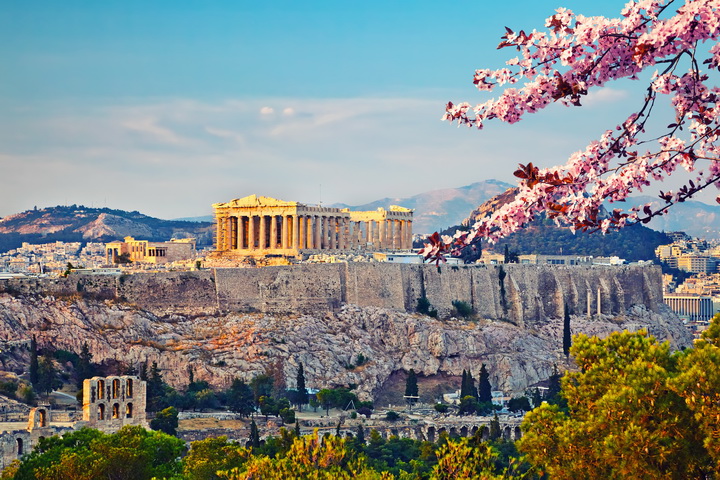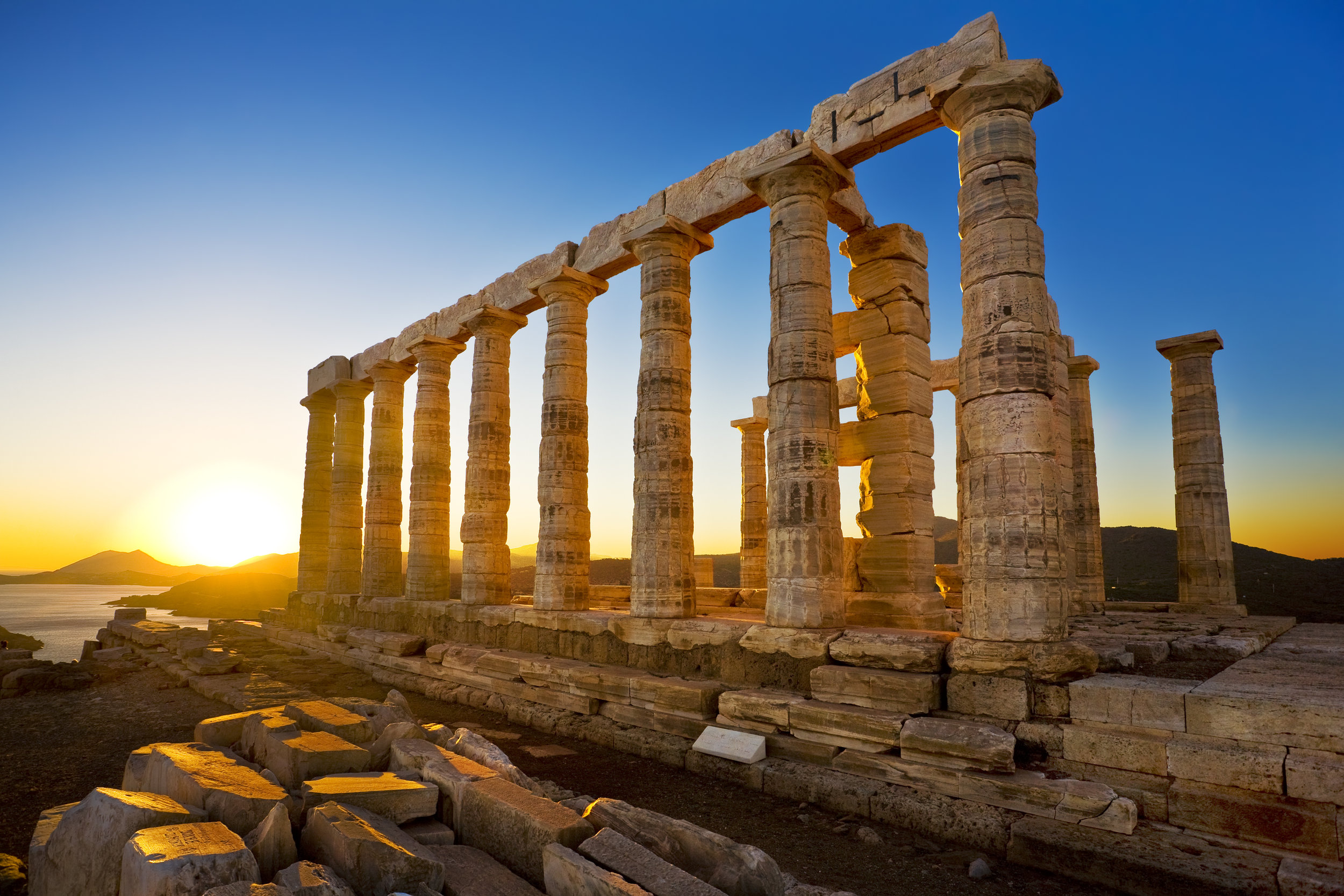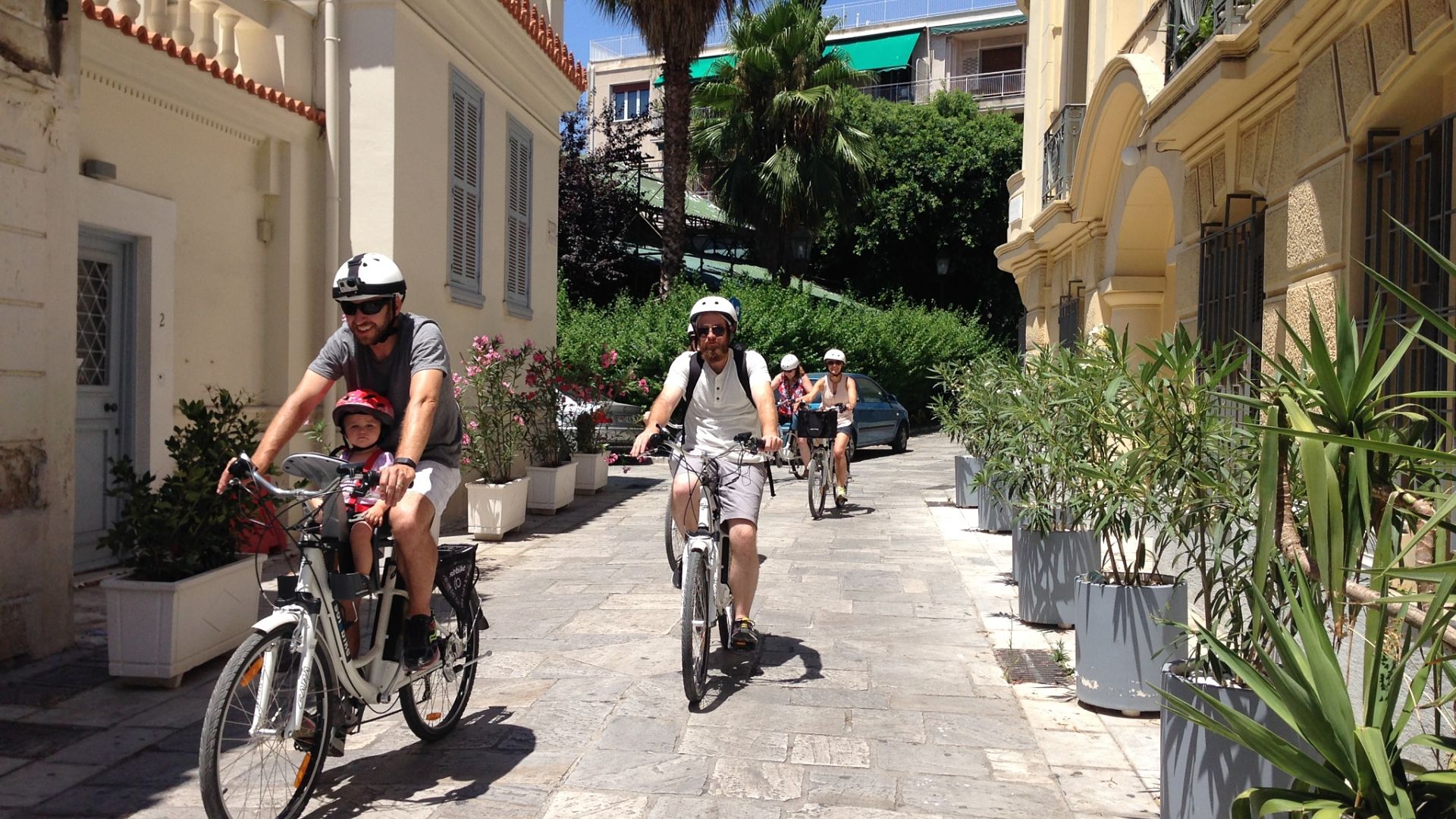by Katherine Poseidon
When is Easter in Greece?
First things first - you may be thinking ‘wait, hasn’t Easter happened already? What’s going on?” The short answer is that the Greek church (along with all other Orthodox Christians) follows an older calendar (the Julian calendar) to calculate the date of Easter Sunday, while everyone else uses the Gregorian calendar, which is thirteen days ahead.
The second part of the answer is that the Orthodox churches celebrate Easter after the Jewish Passover, as per the original Easter story. (In Greek, ‘Pascha’ (Easter) is closely related to ‘Pesach’ (Passover)).
Looking for unique things to do in Athens this season?
Guide to Holy Week
Easter traditions: Lent
Although the Easter dates may be different, the general traditions are similar. Greeks also celebrate Lent, which kicks off with Tsiknopempti - a Mardi Gras-like celebration of grilled meat. Once Lent starts, all animal products are forbidden, so Tsiknopempti (literally ‘Smoky Thursday’) is the last hurrah, eat-as-much-meat-as-you-can day that also kicks off the carnival season.
Lent officially starts on ‘Clean Monday,’ when, curiously, ‘fasting’ begins with another huge feast, but this time with only ‘lenten’ (nistisima) foods. Though few Greeks follow the fasting rules completely, in theory we are meant to abstain from any food that comes from animals who have a spine (i.e. all meat, dairy, and fish). Strict fasting also leaves out olive oil, though few follow these rules. Common throughout the Lenten period are sweets made with tahini (ground sesame seeds) - two different kinds of halva and tahinopita are my favourites!
Side note - this is a great time to be a vegetarian in Greece, as suddenly even the fast food restaurants have offerings like veggie burgers.
Lazarus Saturday and Palm Sunday
Once we reach Holy Week though, the itinerary can get busy and there are plenty of things to do. The Saturday before Holy Week (i.e. the day before Palm Sunday) is called ‘Lazarus Saturday’ and in many areas of Greece marks the beginning of a week long cooking spree. Traditionally, ‘little Lazaruses’ (Lazarakia) are baked - small, spiced (and vegan!) bread/cake in the shape of a little person, which are meant to commemorate the story of Jesus raising Lazarus from the dead.
Palm Sunday is celebrated basically as it is in other Christian traditions - those who attend the church service on Sunday morning collect palm branches, and often decorate the church with them. Often bay laurels are used instead of palms, depending on what is available in the area. Also, Palm Sunday includes a special treat - the fasting rules are loosened and a feast of fish is allowed.
To Do List:
Bake (or at least try!) Lazarakia
Visit a cute church and watch the palm decoration
Taste a 'Palm Sunday' fish lunch
Holy Monday, Tuesday and Wednesday
The first part of Holy Week includes daily church services for the devout, and cookie-baking sessions for the less-devout. Most families have their own recipe for Easter cookies (koulourakia) – my family, which has origins in Asia Minor, makes ‘Attaliotika’ – a family recipe named after Antalya, their hometown. On Monday or Tuesday, families gather together (an Easter tradition) to prepare the cookies for eating on Easter Sunday (since they have dairy, they’re traditionally not meant to be consumed during the fasting period- hands out of the cookie jar!).
On Wednesday or Thursday, depending on tradition, the sweet Easter bread (tsoureki) is baked (though again we’re not supposed to eat it yet), and eggs are dyed. Savoury Easter bread (christopsomo) is also prepared. This is the last day for cooking, as, (according to my grandmother), Friday is a day of mourning where it’s not appropriate to be in the kitchen or to do any household chores.
To Do List:
Taste (or bake!) 'koulourakia' from a local 'fourno' (aka bakery)
Buy 'tsoureki' and 'christopsomo' for the weekend breakfast
Dye (or buy) red eggs for the Saturday evening 'tsougrisma' competition (read below)
Easter in Crete? Join unique tours and activities with amazing locals
Holy Thursday
On Thursday the more serious church services also begin, commemorating the last hours of Jesus’ life and then the crucifixion. The sober mood continues through Friday, with morning church services that mark the bringing down of Jesus’ body from the cross (accompanied by pealing church bells), and at this point an icon (depicting Jesus after the crucifixion) is placed in an elaborate carved canopy, like a funeral bier. In the afternoon, it is not uncommon for the faithful to visit several churches to venerate various icons - it’s a nice excuse to get out and about for sightseeing, and it is a public holiday in Greece so, despite the sadness of the ritual, there is still a festive energy to be felt.
To Do List:
Evening 'church crawling'
Listen to the melodic Thursday evening church hymns
Easter time in Athens smells like spring! Discover fantastic things to do today in the city
Good Friday
Good Friday culminates at sundown with the sombre Epitafios service, which involves a procession around the church. The priests and various officiants carry the canopy with the icon, accompanied by incense and followed by the entire congregation, around the area. Wherever you are for this service it is a sight to see - everyone holds a brown candle (white candles are for later) and the gentle light flickers off the ornate ceremonial vestments of the officiants. In many areas the procession is accompanied by a band playing something like a funeral march.
To Do List:
Pick a church
Get inside (just pretend like you know what you're doing)
Follow the crowd in paying respects to the 'epitafio' and -if it's a custom in your church of choice- duck under the 'epitafio' once you see others doing this
Buy a candle (you may need to carry change! Also buy the little plastic cup to catch candle drippings, and don't say we didn't warn you)
Light candle from people next to you
Follow the procession behind the epitafio
Escape to a local taverna on the way OR return to church
Holy Saturday
Once the procession makes its way back to the church, we take a break from services only to reconvene again on Saturday night, a little before midnight, for the resurrection service. Easter weekend is in full swing, and this is the main event! Everyone gathers at the church with unlit candles, often waiting outside - this is the one day a year when almost everyone goes to church - and some churches have speakers outside so you can keep up with what’s going on within.
Eventually, all the lights are turned off until the priest emerges with the ‘Holy Light’ which is passed throughout the congregation until everyone’s candles are lit. At midnight, the priest announces that Christ has risen, bells ring, and everyone joins in in the Easter hymn proclaiming the resurrection. Family members all embrace and then head for home (and food!), keeping their candles lit so that they can mark their doorframe with a cross in smoke, to bless the house for the coming year.
To Do List:
Take a nap (resurrection is at midnight)
Grab a snack (because you won't have dinner before midnight if you're looking for the day's menu!)
Dress code: formal (dress up as if it's New Year's and you still won't be overdressed!)
Buy new candle (remember to carry change)
Buy 'candle-dripping-protector' (in case you didn't buy one the day before and now regret it)
Light your candle from a neighbour once 'Holy Light' is passed around
Find a protected spot (maybe even inside the church!) and keep away from kids with firecrackers
Prepare - it will get noisy at 12 (and wear earplugs if needed!)
Kiss like it's New Year's after resurrection
Remain at church OR go straight to dinner
Eat magiritsa soup (without asking what's in it) and compete in egg 'tsougrisma'
Easter Sunday
On Easter Sunday there is a final service - the ‘liturgy of love’ where red eggs are distributed to the attendees. This is also the time when you bring back your white candle from the night before, and light it in the church in memory of a loved one.
To Do List:
Ask for the best taverna for a traditional Easter feast OR make local friends (and make sure they invite you to their feast!)
Eat and drink like there's no tomorrow
Dig deeper into Greek gastronomy on your Greek Easter holidays
Greek Easter: What’s on the Menu?
After the midnight resurrection service, the fast is broken and the celebration continues, now around the table! The staple of the early morning Easter meal is a lemony soup called magiritsa - better not to go into detail about the ingredients, but it is made with lamb offal. This may seem like a lot to digest at 2am but apparently the point is to go easy on the stomach (which, remember, is not supposed to have been eating meat).
During this meal we finally get to enjoy all the baked goodies prepared during the previous week: sweet tsoureki, savoury christopsomo, Easter cookies and also our eggs! You may have wondered why Greek Easter eggs are red. The tradition is that red is the colour of life, so the red eggs represent the resurrection.
Instead of Easter egg hunts, Greeks play ‘tsougrisma’ - every family member carefully chooses a strong-looking egg, and then tries to crack it everyone else’s egg with it (while not cracking his own egg in the process). The owner of the victorious egg gets bragging rights but also good luck for the coming year.
When you’re ready to fall into a food coma, there is a small break until the next day. On Easter Sunday, everyone gathers together again in the afternoon for the traditional and well-known lamb on a spit. More red eggs appear, along with a number of other delicious goodies. This is the main Easter celebration, which goes on for most of the day - celebrating with family and friends and making up (or not!) for the 40 days of fasting.
It’s never too early for Greek island hopping!
Regional Traditions
Generally, Holy Week celebrations follow the same framework throughout Greece, but different areas all have local rituals and traditions (and special Easter recipes!). Some highlights include:
Easter in Crete
One of the main highlights of the Easter holiday in Crete is the food - which is unique compared to other parts of Greece. The traditional ‘Lenten’ fare, enjoyed throughout Holy Week up until Easter, is characterised by snails (remember, they don’t have a spine so they’re ok during fasting periods), askordoulaki, an onion-like root, and raw broad beans, topped with raki, the ubiquitous Cretan spirit of choice (when in Rome!). The best part comes later, once dairy is permitted again - little pies stuffed with cheese, known as ‘mizithropitakia’, 'kaltsounia' or ‘lixnarakia.’
Escape Athens and experience the Greek islands and the beautiful mountains of Greece
Easter in Chios
The island of Chios is famous for its ‘rocket war’ on Easter Weekend, which begins right after the resurrection (when the priest declares ‘Christ is Risen’). Two parishes on opposite hilltops fire rockets at each other across the valley, creating an extraordinary sight. This is the most extreme iteration of an Easter tradition of setting off firecrackers at the same point in the festivities - which happens all over Greece.
Easter in Kerykyra (Corfu)
Celebrations on Corfu are accompanied by its famous brass band, but the island also has a more unique Easter custom. The festivities culminate on Holy Saturday with pot smashing - the churches ring their bells while the local Corfiots head to their balconies to drop clay pots (full of water!) onto the streets below. The din is meant to keep evil spirits away!
Easter in Hydra
This little island close to Athens celebrates its seafaring history by carrying the epitafios through the water at one point during the Good Friday procession. Various processions that have set off from different churches and monasteries across the island all converge in the picturesque port town. Book your spot and visit Hydra for a day from Athens!
Easter in Astypalaia
The island of Astypalaia is one of the places in Greece known for making ‘lazarakia,’ the little sweet loafs shaped like a man, in commemoration of Lazarus Saturday. It is also home to another tradition, seen in various areas throughout Greece, of hanging an effigy of Judas during Easter weekend.
Easter in the Greek islands? Planning an escape to Santorini or Mykonos? Discover our 'secret' hand-picked collection
Greek Easter Etiquette
Easter is definitely the biggest religious holiday in Greece, and easily takes pride of place above Christmas. As a result you’ll hear people wishing each other ‘Chronia Polla’ (many years) as soon as the priest declares ‘Christ is Risen,’ and for a solid week after the fact.
In addition it is also very common to greet friends with the phrase ‘Christ is Risen’ (Christos Anesti) and the response is ‘He is Risen Indeed’ (Alithos Anesti). There is also a more generic Easter greeting which is just ‘Happy Easter’ (Kalo Pascha).
The Easter Bunny doesn’t visit homes in Greece like it does elsewhere, and there is not a major tradition of gift giving, aside from new clothing for children and especially new shoes. These usually come from the children’s godparents, who also provide elaborately decorated candles (lambades) for the midnight service on Holy Saturday. Also, since many people visit family members’ homes for meals, edible gifts, including red eggs, tsoureki (my favourite is chocolate covered!), and Easter cookie and chocolate, are common.
A Helpful Glossary of Useful Phrases for Greek Easter
A Greek Easter Recipe
Attaliotika Koulourakia
This is my great-grandmother’s recipe for traditional Easter cookies, or koulourakia. Unlike most cookies, these are not very sweet. We use the recipe year round, making the cookies into squiggly lines ideal for dipping into coffee (think small biscotti style). For Easter, however, we pull out all the stops and make them into little animals - dragons and crabs, with a red egg for garnish.
Makes Lots!
Discover more authentic and unique tours in Athens from our hand-picked collection
Heading to Santorini in Easter time? Don’t miss fantastic tours and activities with local insiders
Like it? Share it!




























